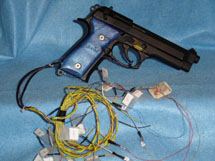Spotlight: Smart Gun Technology Works

Researchers used this fourth-generation replica of smart gun for demonstration purposes. The attached wires would be used to transfer data from the sensors on the gun grips to the digital signals on a processor box. The processor box is not shown. |
January 2005Sixty people crowded into a small room at the Bayonne police firing range to witness smart gun technology. Donald H. Sebastian, senior vice president of research and development at New Jersey Institute of Technology (NJIT), stood near an oversized screen displaying a real-time video of an NJIT policeman shooting an experimental handgun in an adjacent indoor range. Although there was no applause as shots rang out, the action demonstrated that smart gun knew friend from foe. Sixteen electronic computerized sensors embedded in the gun’s grip distinguished known from unknown users. “We’ve only just begun and we’re pleased to say that we’re getting 90 percent reliability when scanning users,” said Sebastian. (NOTE: To view additional smart gun photos, scroll down to the end of this article.) Since 1999, Sebastian has led the smart gun project based upon Dynamic Grip Recognition, a technology invented by Michael Recce, associate professor of information systems at NJIT. Five members of the NJIT police force have been trained since June of 2004 to use the test gun and be recognized. Ultimately computerized sensors in each gun will record data on dozens of known users while also blocking unauthorized users. |
The project has the enthusiastic backing of Sens. Frank R. Lautenberg and Jon S. Corzine. In addition to proudly witnessing the technology, the pair announced in December 2004 that, once again, they had secured $1 million in federal funding for the project; they secured a similar amount the previous year. The funding was included in this year’s U.S. Department of Justice budget. Reps. Robert Menendez and William Pascrell, who have also supported the research and sought federal appropriations, also spoke, as did NJIT President Robert A. Altenkirch and Bayonne Mayor and State Senator Joseph Doria, an early New Jersey legislative supporter.
Under New Jersey law, passed in December 2002, only smart guns can be purchased in the state three years after personalized handguns become commercially available. Lautenberg said New Jersey’s legislative effort to introduce smart gun technology should be a national model for the country. Once Congress returns to session next year, Lautenberg and Pascrell plan to introduce legislation modeled after New Jersey’s law, so families across the country will be able to ensure that guns they own will not fall into the wrong hands.
“Everyone has body features that are unique signatures,” said Sebastian. “Fingerprints and retinas number among the best known markers. Identifying a person by such attributes is called the science of biometrics.”
Another form of biometric—the dynamic biometric—depends on both physical markers and behavior. “This is about who you are and how you do something, said Sebastian. This biometric is the foundation of Dynamic Grip Recognition. The technology measures not only the size, strength and structure of a person’s hand, but also the reflexive way in which the person acts. For smart gun, the observed actions are how the person squeezes something to produce a unique and measurable pattern. Embedded sensors in the experimental gun then can read and record the size and force of the users’ hand during the first second when the trigger is squeezed.
“This technology is similar to how electronic machines read an individual’s signature upon completing a credit card transaction,” said Sebastian.
The next step is for NJIT researchers to turn over their invention to the Australian-based research and development company Metal Storm Ltd. Currently January of 2006 is the target date. Metal Storm will then incorporate the NJIT technology into their patented electronic handgun, as NJIT researchers continue testing.
“NJIT is doing pioneering research to make a firearm that can save thousands of innocent lives,” said Lautenberg during a recent demonstration of the technology at a Bayonne firing range. “On any given day people across the country can turn on their TV news or read in their local paper the sad story of a child taking another child’s life because they got their hands on a loaded gun. However, we know now that these deaths can be prevented—or at least reduced—through technology that will render a gun inoperable in the hands of the wrong user.”
Corzine called the NJIT’s dynamic-grip technology cutting edge and said that it represented a really positive step forward in public safety. “NJIT is involved in important life-saving research,” he added. “There is no question that manufacturing handguns with advanced technology to limit operation can save lives. No child could pick up a gun and pull the trigger. The gun just won’t work, and that’s how it should be.”
Menendez said that by making handguns operable only by authorized users, many gun deaths can be avoided. Pascrell said he looked forward to introducing legislation in the 108th Congress similar to the legislation in New Jersey.
Since 1999, NJIT has spearheaded efforts to develop a personalized handgun that can instantly and reliably recognize one or more pre-programmed authorized users. To date, the New Jersey legislature has awarded NJIT $1.5 million for the project.
In 2003, Recce received a patent for Dynamic Grip Recognition. The invention enabled NJIT electrical engineering professor Timothy Chang, assisted by a team of engineers, to embed multiple small electronic sensors in the grip. The sensors identify the user. The finished gun will eventually feature both electronic features and computerized parts. Recce sees his invention someday also being used in other applications—perhaps the yoke of a plane or a car’s steering wheel.
Also in 2003, NJIT signed an agreement with Metal Storm, which owns a patent for its Electronic Firing System that can be used in a handgun. Metal Storm’s O’DwyerTM VLe® system is a unique, patented approach to firing projectiles. Entirely electronic, the system utilizes preloaded barrels holding multiple projectiles that are fired by electronic ignition. For the first time, interchangeable and multiple barrels can be made available to fire a range of projectiles of varying calibers from the same handgun.

